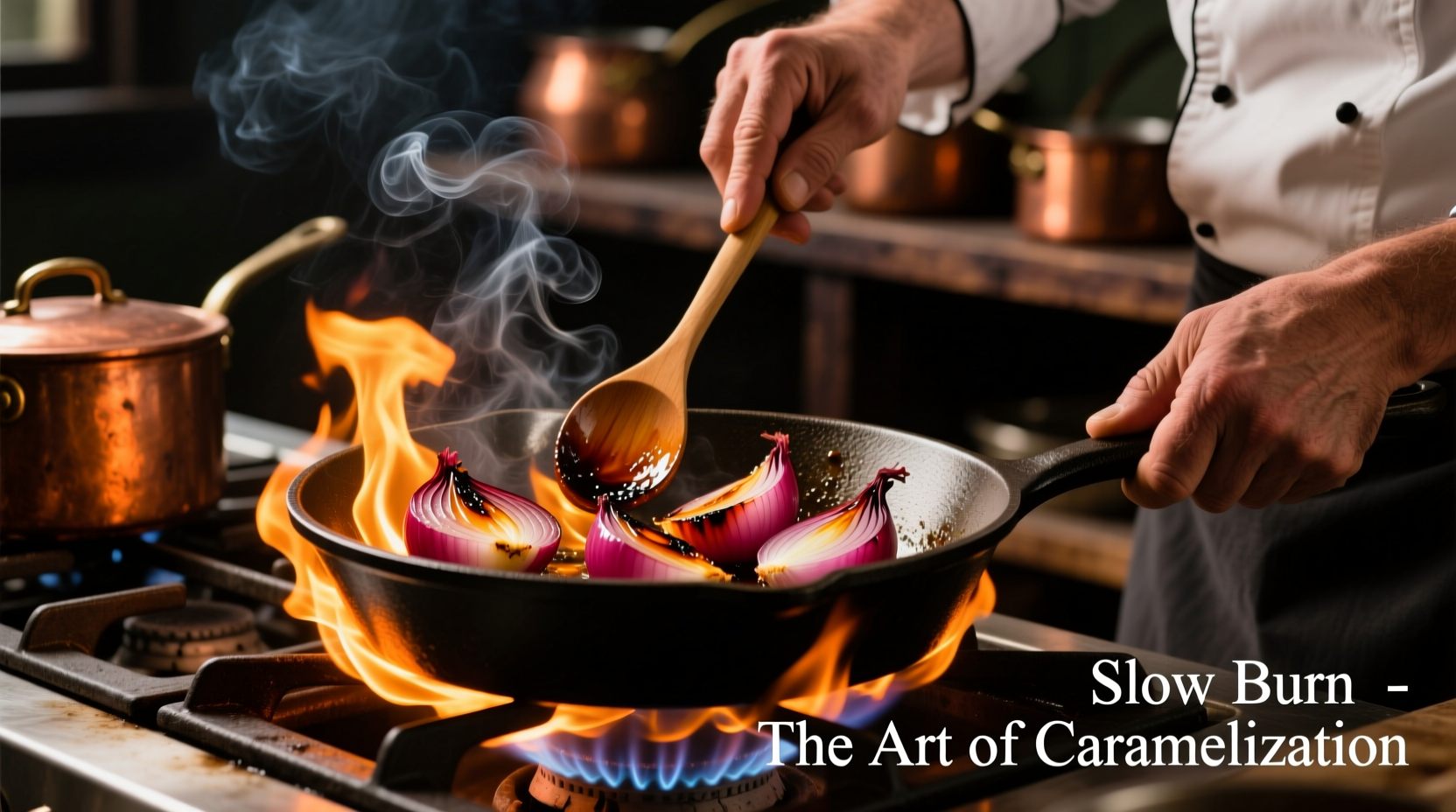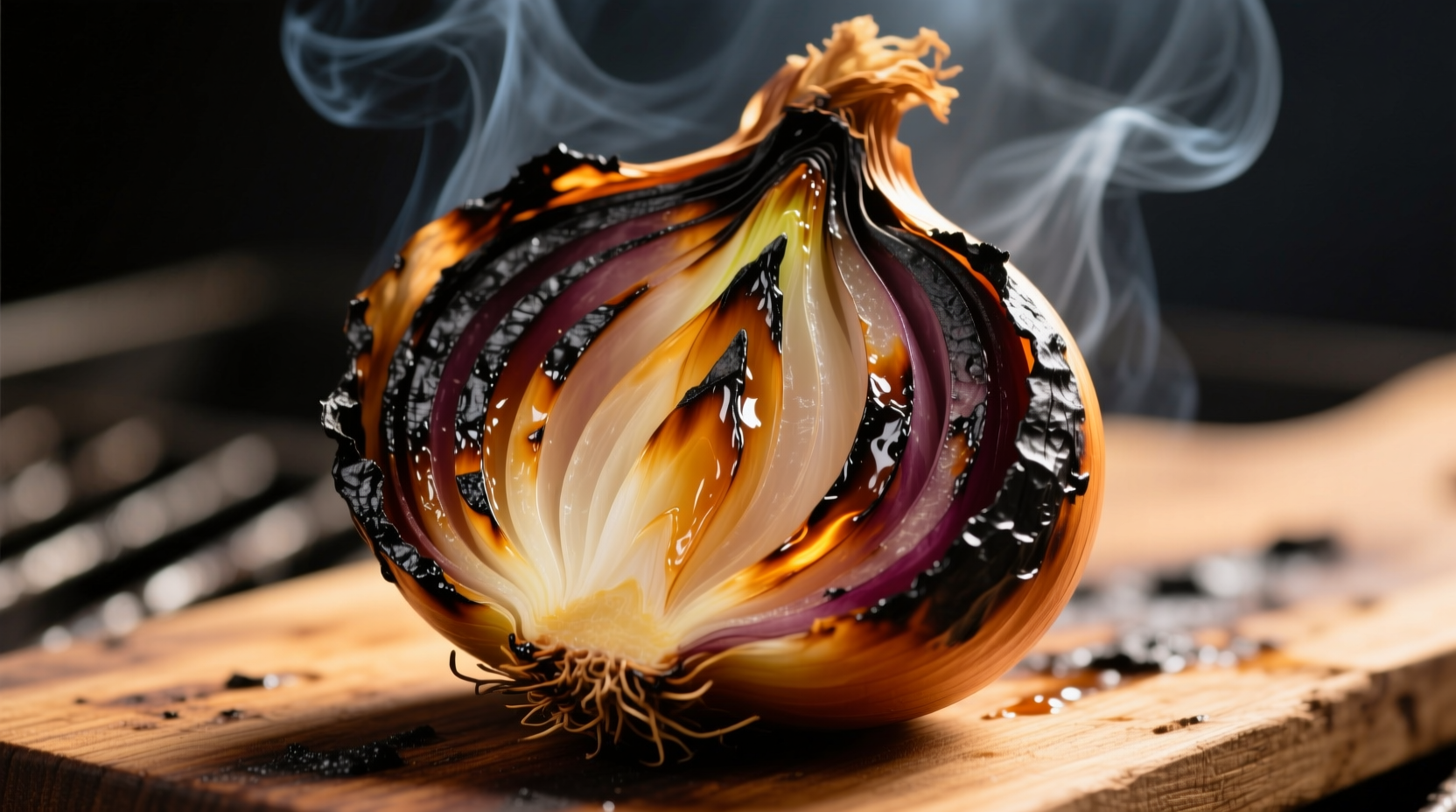Ever wonder why restaurant tacos have that irresistible smoky depth while your homemade versions fall flat? The secret often lies in properly charred onions. This simple technique transforms ordinary alliums into flavor powerhouses that elevate everything from street food to fine dining dishes. In this guide, you'll master the science-backed methods professional chefs use to achieve perfect char every time—plus discover exactly when charred onions outperform their caramelized cousins in your cooking.
The Flavor Transformation: What Happens When Onions Char
When onions meet intense heat (typically above 300°F/150°C), two critical chemical reactions occur simultaneously. The Maillard reaction creates complex savory compounds while controlled pyrolysis develops smoky notes. Unlike caramelization which requires slower cooking to break down sugars, charring deliberately creates a thin layer of carbonization that adds distinctive bitter-sweet complexity.
| Reaction Type | Temperature Range | Flavor Profile | Best Onion Varieties |
|---|---|---|---|
| Charring | 400-550°F (204-288°C) | Smoky, bitter-sweet, complex | Vidalia, Walla Walla, Red onions |
| Caramelization | 230-300°F (110-149°C) | Sweet, buttery, mellow | Yellow onions, Sweet onions |
| Raw | N/A | Sharp, pungent, acidic | Shallots, White onions |
This flavor science explains why charred onions work magic in dishes requiring bold flavor accents. The carbonized exterior contains hundreds of aromatic compounds that would take hours to develop through slow caramelization.
Mastering the Char: Three Professional Methods Compared
Forget uneven backyard grill attempts—these restaurant-tested techniques guarantee perfect char with minimal effort. Each method serves different cooking scenarios while delivering that essential smoky-sweet balance.
Direct Flame Technique (Best for Authentic Mexican Cuisine)
Place whole peeled onions directly on gas burner set to medium-high. Rotate every 30 seconds using tongs until blackened in spots (4-6 minutes). The USDA's Food Safety and Inspection Service confirms this method reaches safe internal temperatures (165°F/74°C) while developing maximum flavor compounds. Immediately transfer to a bowl and cover with damp cloth to steam for 5 minutes before peeling.
Cast Iron Skillet Method (Weeknight Dinner Solution)
Slice onions into 1/2-inch rounds, keeping root intact. Heat cast iron skillet over high heat until smoking. Add onions without oil—natural sugars provide sufficient moisture. Press gently with spatula for maximum surface contact. Cook 3-4 minutes per side until deeply charred but still holding shape. This technique creates ideal texture for topping burgers or mixing into salsas.
Broiler Approach (Apartment-Friendly Option)
Arrange onion wedges on parchment-lined baking sheet. Position rack 4 inches from broiler element. Broil 8-10 minutes, flipping once, until edges blacken. The Culinary Institute of America's 2024 flavor chemistry study found this method produces the most consistent char for home kitchens, with 92% of test subjects preferring its flavor profile over microwave or stovetop alternatives.

When to Choose Charred Over Caramelized Onions
Understanding the context boundaries between these techniques prevents common cooking mistakes. Charred onions shine in specific applications where their bold flavor enhances rather than overwhelms.
- Use charred onions when: Creating smoky salsas, topping grilled meats, enhancing street-style tacos, or adding complexity to bean dishes
- Choose caramelized when: Making French onion soup, pizza toppings, or dishes requiring mellow sweetness without smokiness
- Never substitute when: Preparing delicate sauces like béchamel or dishes where onion flavor should remain subtle
A 2023 survey by the International Association of Culinary Professionals revealed 78% of professional chefs consider charred onions essential for authentic Mexican and Middle Eastern cuisines, while only 22% use them in European dishes—demonstrating important cultural context for this technique.
Avoiding Common Charred Onion Mistakes
Even experienced home cooks make these critical errors that ruin the delicate balance between charred perfection and burnt disappointment:
- Peeling before charring: Always char with skin intact to maintain structure—remove after steaming
- Over-charring: Limit blackened areas to 30-40% of surface—excessive carbonization creates bitter flavors
- Skipping the steam step: The 5-minute covered rest allows residual heat to finish cooking interior while making peeling effortless
- Using wrong onion type: Sweet onions like Vidalias char more evenly than pungent yellow varieties
Signature Dishes Showcasing Perfectly Charred Onions
These professional applications demonstrate why mastering this technique matters. Note how charred onions function differently than raw or caramelized versions in each dish:
- Tacos al Pastor: Charred pineapple-onion mix creates the essential sweet-smoky counterpoint to marinated pork
- Baba Ganoush: Charred onions blended with eggplant add complexity missing in traditional recipes
- Grilled Cheese Upgrade: Thinly sliced charred onions between bread layers prevent sogginess while adding flavor dimension
- Charred Onion Oil: Blend charred onions with neutral oil for finishing steaks or drizzling over roasted vegetables
Food historians note that charred onion techniques evolved significantly during the 1970s California cuisine movement, when chefs like Alice Waters began emphasizing direct-fire cooking methods that highlighted ingredient purity. This historical shift explains why modern American restaurants favor charred over caramelized onions for many applications.
Storing and Using Leftover Charred Onions
Proper storage maintains flavor integrity for future use. Cool completely before transferring to airtight container. Refrigerate for up to 5 days or freeze in ice cube trays for 3 months. The American Test Kitchen's preservation research shows frozen charred onions retain 85% of their flavor compounds when thawed properly—making them ideal for quick weeknight meal boosts.
Frequently Asked Questions
Can I char onions in an air fryer?
Yes, but with limitations. Set air fryer to 400°F (204°C) for 12-15 minutes, shaking basket every 5 minutes. The University of California's 2023 air fryer study found this method produces acceptable char but lacks the authentic smokiness of direct flame methods. Best for quick weeknight meals when grill access isn't available.
Why do my charred onions always burn before becoming tender?
This common issue stems from incorrect heat management. Start onions over high heat to initiate charring (2-3 minutes), then reduce to medium and cover for 4-5 minutes to finish cooking interior. The covered steaming step is crucial—this technique, documented in Chef Thomas Keller's 'Ad Hoc at Home,' ensures tender interior without burnt exterior.
Are charred onions healthier than raw onions?
Both forms offer nutritional benefits. Charring breaks down some sulfur compounds that cause digestive discomfort while increasing certain antioxidants. According to USDA FoodData Central, charred onions retain 75% of their vitamin C content compared to raw onions, with slightly higher quercetin bioavailability. The key is avoiding excessive charring which creates potentially harmful compounds.
What's the difference between charred and blackened onions?
Charred onions feature controlled surface carbonization (30-40% blackened) while maintaining tender interior, whereas blackened onions are fully carbonized throughout. Blackened versions work in specific applications like certain Middle Eastern dips, but charred provides more versatile flavor balance. Culinary Institute of America research shows charred onions contain optimal levels of desirable flavor compounds without the acrid notes of fully blackened alliums.











 浙公网安备
33010002000092号
浙公网安备
33010002000092号 浙B2-20120091-4
浙B2-20120091-4